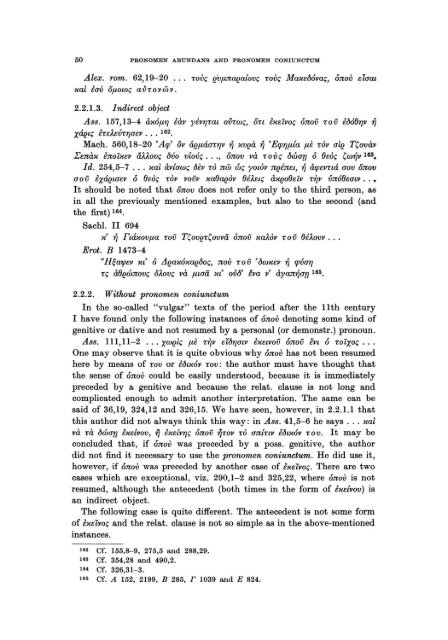Pronomen Abundans and Pronomen Coniunctum. A ... - DWC
Pronomen Abundans and Pronomen Coniunctum. A ... - DWC
Pronomen Abundans and Pronomen Coniunctum. A ... - DWC
You also want an ePaper? Increase the reach of your titles
YUMPU automatically turns print PDFs into web optimized ePapers that Google loves.
50 PRONOMEN ABUNDANS AND PRONOMEN CONIUNCTUM<br />
Alex. rom. 62,19-20 ... rovç (iVflnaealovç rovç Ma"eMvaç, ónov elaat<br />
"al èav OflOtoÇ avrovwv.<br />
2.2.1.3. Indirect object<br />
Ass. 157,13-4 à"óW/ èàv yév1'Jtat ovrwç, on è"ûvoç ónov rov èbó()1'Jv iJ<br />
xáetç èreÄ.evirwev . .. 162.<br />
Mach. 560,18-20 'Ag!' 81' áefláar1'Jv iJ "veà iJ 'EfP1'Jflla flè rol' ale TÇovàv<br />
Eenà" ènoi"ev äUovç bvo vLovç . .. , onov và rovç bwan ó ()eoç !;w~v 163.<br />
Id. 254,5-7 ... xal àvlawç bèv ro nw wç yotOV neénet, iJ àfPevná aov onov<br />
aov èxáetaev ó ()eoç rol' vovv "a()aeov ()é).etç à"eo()ûv .r/v vnó()eatv ..•<br />
It should be noted that onov does not refer only to the third person, as<br />
in all the previously mentioned examples, but also to the second (<strong>and</strong><br />
the fust) 164.<br />
Sachl. II 694<br />
,,' iJ Ttá"ovfla rov T!;over!;ovvä ónov "aÀov rov ()é).ovv ...<br />
Erot. B 1473-4<br />
"H~U'lpev Xt' ó Llea"óxaeboç, nov rov 'bw"ev iJ fPVa1'J<br />
rç à()ewnovç oÀovç và fltaä "t' ovb' [va v' àyan~an 165.<br />
2.2.2. Without pronomen coniunctum<br />
In the so-called "vulgar" texts of the period af ter the lIth century<br />
I have found only the following instances of ónov denoting some kind of<br />
genitive or dative <strong>and</strong> not resumed by a personal (or demonstr.) pronoun.<br />
Ass. 111,11-2 ... xwel,ç flè .r/v e'tb1'JC1tv è"etvov ónov in ó roixoç ...<br />
One may observe that it is quite obvious why ónov has not been resumed<br />
here by means of rov or èbt"óv rov: the author must have thought that<br />
the sense of ónov could be easily understood, because it is immediately<br />
preceded by a genitive <strong>and</strong> because the relat. clause is not long <strong>and</strong><br />
complicated enough to admit another interpretation. The same can be<br />
said of 36,19, 324,12 <strong>and</strong> 326,15. We have seen, however, in 2.2.1.1 that<br />
this author did not always think this way: in Ass. 41,5-6 he says ... "al<br />
, '.I: I " .l\" • -,J; , I '.I: I<br />
va ra uwan e"etvov, It b<br />
'I e"etv1'Jç onov ,(COl' ro ant1:tv eut"OV rov. may e<br />
concluded that, if ónov was preceded by aposs. genitive, the author<br />
did not find it necessary to use the pronomen coniunctum. He did use it,<br />
however, if ónov was preceded by another case of è"ûvoç. There are two<br />
cases which are exceptional, viz. 290,1-2 <strong>and</strong> 325,22, where ónov is not<br />
resumed, although the antecedent (both times in the form of è"elvov) is<br />
an indirect object.<br />
The following case is quite different. The antecedent is not some form<br />
of è"ûvoç <strong>and</strong> the relat. clause is not so simple as in the above-mentioned<br />
instances.<br />
162 Cf. 155,8-9, 275,5 <strong>and</strong> 288,29.<br />
163 Cf. 354,28 <strong>and</strong> 490,2.<br />
164 Cf. 326,31-3.<br />
165 Cf. A 152, 2199, B 285, r 1039 <strong>and</strong> E 824.
















